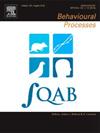Acquired human speech sounds replace conspecific syllables in the song of Budgerigars Melopsittacus undulatus
IF 1.3
4区 生物学
Q4 BEHAVIORAL SCIENCES
引用次数: 0
Abstract
The psittacine budgerigar Melopsittacus undulatus, a parrot species known to be a vocal learner, produces long and complex songs composed of different syllable types. Budgerigars can imitate heterospecific sounds as new song syllables, including human speech, but it is unclear how the imitative sounds affect the proportion of different syllables or high-order song structure, such as temporal pattern, which is characteristic of the budgerigar song. We analyzed recordings of songs from six adult male budgerigars with or without imitations of Japanese words to identify whether songs with imitations differed in structure from those without imitations. Songs with imitations contained significantly fewer narrowband syllables and more harmonic syllables, including imitative vocalizations, than those with no imitations. On the other hand, there were no significant differences in most of the temporal parameters between songs with and without imitations, suggesting that the high-order song structure was less affected by incorporating newly acquired syllables. These observations suggest that the heterospecific imitations replaced the conspecific narrowband syllables, which are frequently seen in normal budgerigar song and are acquired through learning processes, possibly without changing the temporal pattern in the song of budgerigars.
习得的人类语音取代了波状虎牙歌声中的同种音节
波状鹦鹉(Melopsittacus undulatus)是一种已知会学习声音的鹦鹉,能发出由不同音节类型组成的又长又复杂的歌曲。虎皮鹦鹉可以模仿不同的声音作为新歌的音节,包括人类的语言,但目前还不清楚这些模仿的声音如何影响不同音节的比例或高阶的歌曲结构,如时间模式,这是虎皮鹦鹉歌曲的特征。我们分析了六只成年雄性虎皮鹦鹉在模仿或不模仿日语单词时的歌曲录音,以确定模仿的歌曲在结构上是否与不模仿的歌曲不同。有模仿的歌曲比没有模仿的歌曲包含更少的窄带音节和更多的和声音节,包括模仿的发声。另一方面,有模仿和没有模仿的歌曲在大多数时间参数上没有显著差异,这表明加入新获得音节对高阶歌曲结构的影响较小。这些观察结果表明,异种模仿取代了在正常虎皮鹦鹉鸣叫中经常出现的同质窄带音节,这些音节是通过学习过程获得的,可能不会改变虎皮鹦鹉鸣叫的时间模式。
本文章由计算机程序翻译,如有差异,请以英文原文为准。
求助全文
约1分钟内获得全文
求助全文
来源期刊

Behavioural Processes
生物-动物学
CiteScore
2.70
自引率
7.70%
发文量
144
审稿时长
4-8 weeks
期刊介绍:
Behavioural Processes is dedicated to the publication of high-quality original research on animal behaviour from any theoretical perspective. It welcomes contributions that consider animal behaviour from behavioural analytic, cognitive, ethological, ecological and evolutionary points of view. This list is not intended to be exhaustive, and papers that integrate theory and methodology across disciplines are particularly welcome.
 求助内容:
求助内容: 应助结果提醒方式:
应助结果提醒方式:


